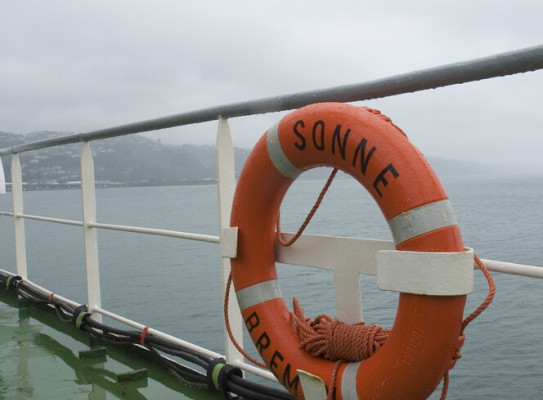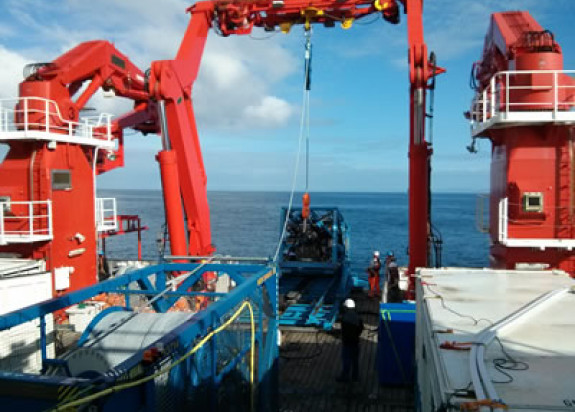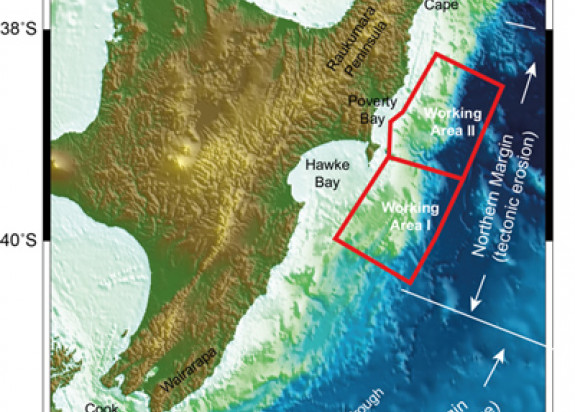Scientists investigate seafloor landslides off the North Island's East Coast

A German research ship, Sonne, is undertaking a four-week voyage off the Poverty Bay and Hawke's Bay coast investigating the geology of the seafloor with a particular focus on areas of the seafloor that move like landslides.
Scientists are not sure what is causing the slow-moving under-sea landslides and they are testing several theories through the use of a robotic sampler on the ship and mapping the seafloor as well as collecting measurements such as temperature and gravity.
Two marine geophysicists from GNS Science in Wellington are participating in this joint German-New Zealand voyage and are based largely in a control room in the centre of the ship watching the data come in, making maps, and deciding on the best places to deploy the robotic sampler.
Stuart Henrys, one of the GNS Science researchers, says one of the theories they are testing is that gas hydrates may be influencing the way the seafloor rock mass moves by making it behave like a glacier.
We are hoping to recover landslide material to see if gas hydrates are part of the rock mixture on the seafloor. We have geologists on board to describe the sediment we recover. We also have geochemists to analyse the sediments to detect any traces of hydrates.
The robotic system, specially developed in Germany for marine research, is capable of drilling down to about 200m below the seafloor and bringing samples back to the ship for analysis.
The 116m-long Sonne is the flagship vessel of the German research fleet. It was launched in 2014 and is booked for up to three years in advance for research projects mainly in the Pacific and Indian Oceans. It can accommodate up to 40 scientists for research voyages lasting up to 52 days.
The former German research ship of the same name has visited New Zealand several times in the past 20 years as part of an international research effort to improve the understanding of the geology of the seafloor off the East Coast, with a focus on the Hikurangi Subduction Zone and gas hydrates under the seafloor.
Both these natural features are internationally significant and progress in understanding them has implications for many countries as well as New Zealand.

Note:
Gas hydrates, or methane hydrates, are a gas-rich ice crystal that has been described as looking like sorbet. New Zealand has some of the most extensive deposits of this frozen form of methane in the world.
The largest gas hydrate ‘province’ is on the Hikurangi Margin, east of the North Island.
It covers roughly 50,000 square kilometres. Scientists estimate that if only a fraction of this resource could be recovered economically, it would be the main source of natural gas for New Zealand for many decades. A feature of New Zealand's accumulations is the relatively high number of 'sweet spots', where hydrates tend to concentrate.
New Zealand is one of about 15 countries investigating the possibility of extracting gas hydrates from their territorial waters. Japan is seen as the leader in hydrate research.
Its hydrate accumulations could potentially meet its energy needs for the next century.
Recent advances in Japan could potentially bring forward commercial production of hydrates in several countries. At present the cost of extracting hydrates is unattractive compared to conventional gas production. However, the cost of hydrate production will inevitably come down, making it more attractive.
Gas hydrates are also of interest to scientists because of the effect they can have on the stability of the seafloor. Small changes in the temperature of the ocean can cause them to lose structure and behave like liquid and this can trigger movements in the ocean floor.
